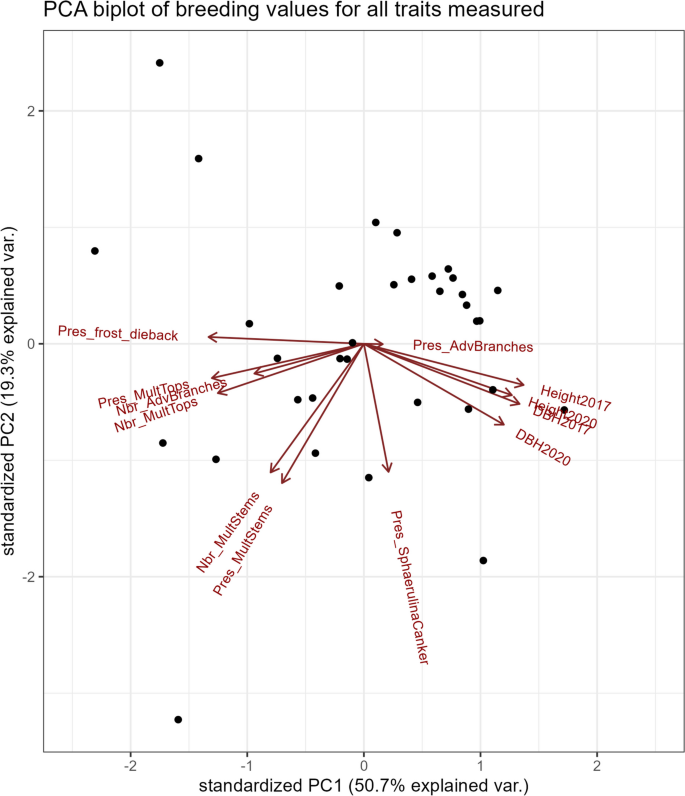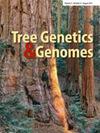Preliminary estimates of genetic parameters and familial selection for non-native poplars show good potential for genetic gains on growth, cold hardiness, trunk quality and Sphaerulina musiva susceptibility
IF 1.6
3区 生物学
Q2 FORESTRY
引用次数: 0
Abstract
Abstract Genetic parameters for growth, trunk quality, and susceptibility to frost and Sphaerulina musiva attack were estimated from 34 half-sib families of hybrid poplar from the crossing of non-native parents, Populus maximowiczii A. Henry, and Populus trichocarpa Torr. & Gray, 3 and 6 years after planting. The use of spatial analysis proved to be the best method for quantitative growth data. The proportion of the among-family variance to the total (phenotypic) variance as well as the high heritabilities of growth and susceptibility to frost and Spaherulina musiva showed a high potential for selection for these traits while the quality traits were under low genetic control. Some families showed gains for several traits, suggesting the possibility of developing a selection index to obtain superior families that show gain for not only growth but quality and adaptive traits as well. Type B correlations were high, suggesting that families responded in the same way regardless of the site. High type A correlation between growth traits at 3 and 6 years showed early selection potential, although these relationships should be confirmed with future measurements to evaluate this effect at maturity. These results can be integrated into the strategy for improving hybrid poplar parental populations and, in the longer term, will make it possible to optimize the selection of individuals with traits of interest for the operational deployment of hybrid poplar clones.

对外来杨树的遗传参数和家族选择的初步估计表明,外来杨树在生长、抗寒性、树干品质和球藻敏感性等方面具有良好的遗传增益潜力
摘要以非本地亲本杨杨(Populus maximowiczii A. Henry)和杨杨(Populus trichocarpa Torr)杂交的34个半同胞家系为材料,分析了其生长、树干品质、对霜冻和霉病的敏感性等遗传参数。,灰色,种植后3年和6年。采用空间分析方法是定量分析增长数据的最佳方法。家族间方差占总(表型)方差的比例以及生长、霜冻敏感性和草叶的高遗传力表明,这些性状具有较高的选择潜力,而品质性状的遗传控制较低。有些家族在几个性状上都有增益,这表明有可能建立一种选择指数,以获得不仅在生长性状上有增益,而且在品质和适应性状上也有增益的优良家族。B型相关性很高,这表明无论地点如何,家庭的反应都是一样的。3岁和6岁时生长性状之间的高A型相关性显示了早期选择潜力,尽管这些关系应该通过未来的测量来确认,以评估成熟时的影响。这些结果可作为杨树杂交亲本群体改良策略的参考,并为杨树杂交无性系的操作部署优化选择具有感兴趣性状的个体提供了可能。
本文章由计算机程序翻译,如有差异,请以英文原文为准。
求助全文
约1分钟内获得全文
求助全文
来源期刊

Tree Genetics & Genomes
生物-林学
CiteScore
4.40
自引率
4.20%
发文量
38
审稿时长
2 months
期刊介绍:
Tree Genetics and Genomes is an international, peer-reviewed journal, which provides for the rapid publication of high quality papers covering the areas of forest and horticultural tree genetics and genomics.
Topics covered in this journal include:
Structural, functional and comparative genomics
Evolutionary, population and quantitative genetics
Ecological and physiological genetics
Molecular, cellular and developmental genetics
Conservation and restoration genetics
Breeding and germplasm development
Bioinformatics and databases
Tree Genetics and Genomes publishes four types of papers:
(1) Original Paper
(2) Review
(3) Opinion Paper
(4) Short Communication.
 求助内容:
求助内容: 应助结果提醒方式:
应助结果提醒方式:


